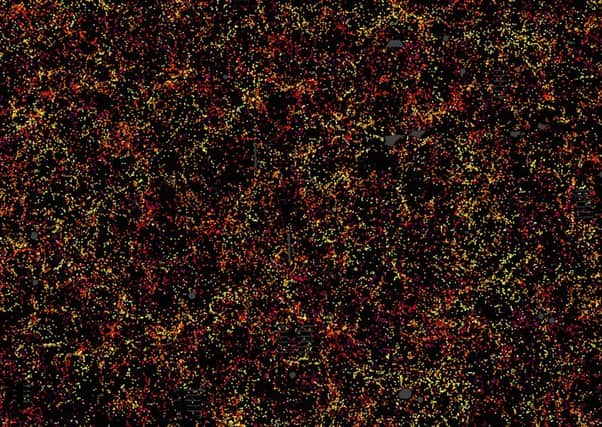Scientists put 1.2m galaxies on largest 3D space map ever made


Dr Rita Tojeiro has led hundreds of international scientists on the Sloan Digital Sky Survey III (SDSS-III), which has taken 10 years to complete.
The map gives the most precise measurement to date of the dark energy – a largely mysterious force – currently driving the expansion of the Universe.
Advertisement
Hide AdAdvertisement
Hide AdDr Tojeiro said: “Over the last decade we have prepared and conducted the largest survey of the Universe yet.
“By measuring the positions of 1.2 million galaxies over one quarter of the sky, we mapped the three-dimensional structure of the Universe over a volume of 650 cubic billion light years.
“Using this map we were able to make some of crispest measurements yet of how dark energy is driving the expansion of the Universe.”
Measurements were taken using the Baryon Oscillation Spectroscopic Survey (BOSS) program of SDSS-III, which charts changes in the density of space over time.
The technology created an “unprecedented and ambitious” galaxy map, many times larger than previous surveys.
The team were able to judge how far apart the galaxies were positioned 13.48 billion years ago and how dark matter and dark energy have competed in the expansion of the Universe since then.
Researchers now believe the universe has been evolving very slowly – if at all – with the growth no more than 20 per cent over 7 billion years.
Dr Tojeiro, a research fellow at the university, added: “If we were to scale the volume of our survey to a cube (that measured) one mile on each side, then the visible part of an individual galaxy would be about 1 millimetre across.
Advertisement
Hide AdAdvertisement
Hide Ad“Our challenge in the analysis of this map was equivalent to measuring the distances between all the pairs of galaxies separated by 100 yards throughout a cubic mile of space.”
BOSS measures the expansion rate by tracking changes in baryonic acoustic oscillations (BAO), or ripples in density, with scientists able to gain accurate results as far back as when the universe was just 400,000 years old.
Dr Tojeiro said the mapping results had offered a “great boon for cosmology.”
Dark energy is known to have significantly influenced the expansion of the Universe from around 5 billion years ago.
The St Andrews-led research follows findings of the Hubble Space Telescope (HST) observations in 1998, which concluded that expansion of the universe had been accelerating.
Theorists later concluded that dark energy was at play.
The new map also reveals they way galaxies move towards regions of the Universe which have more matter, due to the attractive force of gravity.
A collection of papers describing these results was submitted this week to the Monthly Notices of the Royal Astronomical Society.
Dr Tojeiro worked with colleagues from across North and South America to complete the map with universities in England and Europe also involved in the project.
Advertisement
Hide AdAdvertisement
Hide AdShe funded her project-related travel using her 2015 L’Oréal-UNESCO For Women In Science Fellowship (FWIS) award.
The fellowships reward outstanding female postdoctoral researchers, with the aim of encouraging greater participation of women in the field of science
Dr Tojeiro was one of five winners out of 350 applicants.